Transcription of Eucalyptus - Food and Agriculture Organization
1 1 Development of Eucalyptus Plantations - an Overview1 Senior Forest Officer (Plantations) Forest Resources Development Branch Forestry Department FAO Summary The rate of forest plantation establishment has increased sharply in the past decade, particularly in Asia and the Pacific, and species of Eucalyptus have been among the most important components of such plantation programmes. The rate of deforestation has also increased sharply in the same period, and although the reported figures suggest that output from plantation expansion may keep pace with forest loss, nevertheless plantations cannot provide the full range of goods and services of the natural forest.
2 There is, furthermore, doubt about the reliability of reported plantation area figures. Nevertheless the eucalypts have great potential for wood production as well as for the provision of some services, which could be increased through tree improvement or biomass plantations. Plantation programmes could be promoted through the use of incentives, as has happened elsewhere in the world. No plantation programmes, with Eucalyptus species or any other, can succeed, however, without awareness of the political processes necessary for success, including reliable information, participation in decision-making and management by rural people and careful planning and evaluation of the social consequences of environmental or economic effects.
3 Introduction Global demand for all wood products is increasing, but the forest resources of the world are decreasing. Total world roundwood production is predicted to grow by yearly, to reach billion cubic metres by the year 2000 (Gauthier, 1991), and by the year 2025 it may be billion cubic metres (Sharma, 1992). Some of the demand will be met from managed natural forests but that resource will have been diminished by an unknown but probably considerable amount due to forest destruction and degradation in the tropics. Deforestation has been particularly severe in Asia and the Pacific.
4 FAO's recently-completed Forest Resource Assessment of the tropical countries (FAO, 1993a) estimates that the rate of deforestation in the region between 1981 and 1990 was million ha per year, or yearly. While the amount of forest lost is less in Asia and the Pacific than in Africa or Latin America and the Caribbaean, the rate is higher and the resource base is appreciably lower (see Table 1, Annex 1). The difference between supply from the natural forests and demand must be met from planted trees. Trees in plantations have considerable production potential. This is illustrated by such arresting statements as the extrapolation that an area of 150 million ha of fast-growing plantations, or 1% of the world's surface, could provide the present global demand for all types of wood (Wilson, 1993).
5 1 Ball, (1995). Development of Eucalyptus Plantations - an Overview. Proceedings of the Regional Expert Consultation on Eucalyptus , Bangkok, Thailand 4-8 October 1993. Vol .I. 2 Several countries have already invested heavily in forest plantations to meet the demand for some forest products. Chile, New Zealand, Brazil, Spain and Portugal are examples of countries with plantation programmes aimed at the export market, and the eucalypts are important components of the programmes especially in the last three mentioned. Plantations in both Brazil and Argentina, for instance, produced 60% of the country's industrial roundwood but comprise only 2% of the forest area, (Pandey, 1992) and Brazilian exports accounted for of the world market for pulp and paper in 1988 (Gauthier, 1991).
6 If the solution to the problem of wood supply is so simple, one wonders what are the problems to prevent it from being put into effect? Unfortunately there are many constraints. Shortage of land that is both available and sufficiently fertile is one, shortage of money and the weakness of existing institutions are others. These could be overcome if the will is there. Unfortunately the politics2 of plantations are the main and intractable constraint to their development, and in no case is it more so than with the use of species of the genus Eucalyptus in plantation programmes. The objectives of this contribution to a joint paper on the eucalypts in the south east Asian region are to put the growing of the eucalypts in their global perspective, to draw attention to the need for data but also to the dangers of over-generalization concerning the hazards of growing plantations of the genus, to identify some new trends in forest plantation management and objectives and to stress the need for an involved and informed public in the political process which leads to plantation development.
7 Area of Eucalyptus Plantations3 Plantation Areas in the Tropics (Table 2, Annex 1) During the period 1981-90 the area of forest plantations in the tropics is reported to have increased by an estimated million ha yearly, to reach a total gross area of million ha. About 85% of that gross area was established in just five countries: India, Indonesia, Brazil, Vietnam and Thailand. It is relevant to the theme of this meeting that four of those five countries lie in Asia. Over 60% of the gross area of the plantations was described as "non-industrial" and 10 million ha, or nearly one quarter of the gross area, were planted with one genus, the Eucalyptus .
8 Asia and the Pacific Region (Table 4, Annex 1) The increase in the gross global area of forest plantations occurred mainly in Tropical Asia and the Pacific during the period 1981-1990, at the rate of million ha/year (or 81% of the global increase in forest plantations during the period). If this this gross area represents new plantations, and not just areas where plantations have been harvested and replaced with plantations (either of the same of a different species), and if it has adequate stocking, then it is just over half of the area deforested (see above). It appears that future outurn from the gross area of plantations could more than replace the potential for wood production that has been lost.
9 But there are a lot of proviso's. 2 The Concise Oxford Dictionary defines politics as the "science and art of government"while Webster's Ninth Collegiate Dictionary includes "the total complex of relations betweenpeople in society". Both may be illustrated by the phrases "Politics is about power" and"Politics is the art of the possible".3 The source of the information on area figures of tropical plantations, unless otherwisestated, is Pandey, 19923 Have these new plantations survived? Have they been maintained? Will they yield as much as was planned? Nor should it be forgotten that they cannot provide the full range of goods and services that came from the natural forest.
10 The area of Eucalyptus plantations in Tropical Asia and the Pacific was million ha in 1990, or just over half of the global total for the genus (Table 3, Annex 1). Most of that area was in India where a total of million ha of Eucalyptus species were reported, and most of the plantation area in India and elsewhere were planted for non-industrial outputs (see below, Incentives). Species of eucalypt are the most common constituent of forest plantations in Tropical Asia and the Pacific. The area of pines in 1990 was reported as million ha and the area of teak was million ha. In considering the non-forest plantations, the area of rubber in Asia in 1990 was estimated as 7 million ha, of coconut as 4 million ha and of oil palms as over 2 million ha (Pandey, 1992).














